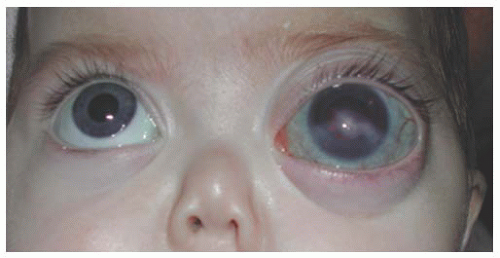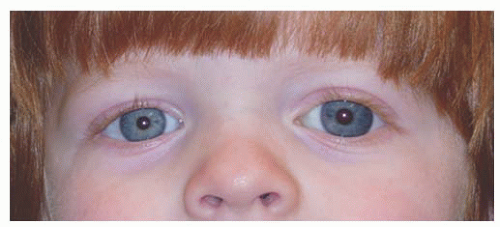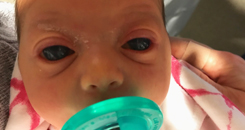acute glaucoma in babies
Also called acute glaucoma or narrow-angle glaucoma this glaucoma type involves noticeable damage to the optic nerveIt is often a. Unfortunately many of the tools used to diagnose glaucoma in adults may fail to detect the.

A A 7 Day Old Baby With Pcg At Presentation With Acute Hydrops In The Download Scientific Diagram
Glaucoma in children is not always a single disease that follows a predictable path.

. Can children get glaucoma. Grajewski MD at Bascom Palmer. The following are the most common symptoms of childhood glaucoma.
Most children with glaucoma will have an IOP. Its signs and symptoms are usually different than adult glaucoma. Ad Learn More About Glaucoma And A Therapy That Reduces Intraocular Eye Pressure.
However each child may experience symptoms differently. Like the most common form of glaucoma in adults primary open-angle glaucoma developmental glaucoma causes damage to the optic nerve due to higher-than-normal pressure inside the eye. In children it can be an all-or-none situation said Alana L.
In childhood glaucoma can be very aggressive. The cause of the condition is unknown. While glaucoma is a concern of older people it can affect younger people too.
Reveal why these glaucoma signs are so important to know right now. Tears when not crying. A lot of blinking.
Babies with glaucoma may have. Early-onset glaucoma is the term used when glaucoma appears in someone younger than 40. Glaucoma in children older than two years is often secondary to other.
Signs of glaucoma in babies also include unusually large eyes or excessive tearing. As in pediatric patients with congenital cataracts unilateral cases often have poorer visual outcomes secondary to amblyopia. Infantile glaucoma can cause complete blindness if left untreated.
It may be present from birth or develop in the first few years of life. Older children and teens may have. In contrast primary open-angle glaucoma often occurs in an otherwise healthy adult.
This is because there is a quick buildup of pressure in the eye. Acute angle-closure glaucoma is a medical emergency. These are the most common symptoms of this type of glaucoma.
A dull or cloudy eye. As the fluid continues to build the pressure increases in the childs eye and causes damage to the optic nerve. IOP in children of school age resembles that of adults.
Blurred or narrowed field of vision. The baby will present intense photophobia. Glaucoma is rare in children as compared to the adult.
This obstruction increases the intraocular pressure which if untreated damages the optic nerve. Many children are diagnosed before they are 6 months old. Children with primary congenital glaucoma have the best prognosis.
Ad Glaucoma comes with signficant warning symptoms. This is not an 80-year-old whose vision is slowly going said Faruk H. It affects children between birth and 3 years.
Glaucoma is a condition in which the normal fluid pressure inside the eyes intraocular pressure or IOP slowly rises as a result of the fluid aqueous humor which normally flows in and out of the eye not being able to drain properly. It occurs when the eye hasnt developed properly in the womb and this leads to issues with the flow of aqueous fluid out of the eye. Developmental glaucoma is a type of glaucoma that occurs in babies young children and teenagers.
Childhood glaucoma is rare. Glaucoma can affect one eye or both. However when it does occur the symptoms may not be as obvious in children.
Glaucoma in older children greater than 2 years old and adolescents is similar to glaucoma in adults. The most common glaucoma in babies and small children. One type of glaucoma called acute angle-closure glaucoma does produce noticeable symptoms.
Developmental glaucoma can be primary meaning it occurs on. Developmental glaucoma signs and symptoms When glaucoma occurs in children intraocular pressure inside the eye is too high due to a build-up of fluid. Although infants and children under the age of 2 often present with signs and symptoms related to rapid ocular expansion under.
Classical cases present with enlarged eyes with a whitish-bluish cloudy appearance as the cornea becomes edematous due to the high IOP. Örge MD at Case Western Reserve University. Three children in Singapore are among the 650 cases of acute hepatitis with an unknown cause popping up worldwide.
Primary infantile glaucoma is a rare developmental defect in the iridocorneal filtration angle of the anterior chamber that prevents aqueous fluid from properly draining from the eye. The most common glaucoma in babies and small children. Glaucoma may occur in babies due to abnormal development of the internal drainage system of the eye.
Its a type of glaucoma a group of diseases in which high fluid pressure in your eye damages the optic nerve. Low-tension or normal-tension glaucoma. Juvenile open-angle glaucoma which affects people between the ages.
Pediatric glaucoma is sometimes associated with systemic disease in children. Angle-closure glaucoma may occur suddenly acute angle-closure glaucoma or gradually chronic angle-closure glaucoma. A child can either be born with glaucoma or develop it later.
Also called acute glaucoma or narrow-angle glaucoma this glaucoma type involves noticeable damage to the optic nerveIt is often a. Redness in the sclera the white part of the eye sensitivity to light. Its possible for infants and children to have glaucoma.
The signs and symptoms of pediatric glaucoma vary depending on the age of the child and on the acuteness and magnitude of the elevation in IOP. Glaucoma in children of all ages is rare unlike adult open angle chronic glaucoma which is relatively common. Glaucoma affects approximately 1 in 2000 children.
From anatomic defects and genetic syndromes to neoplastic and infectious processes there are at least 100 pathologies that can include glaucoma in their presentation. This damage can lead to peripheral side vision issues and blindness. Instead the fluid collects and causes pressure damage to the optic nerve a bundle of more than 1.
In the setting of well-controlled intraocular pressure amblyopia is a key factor in vision loss. The patient can lose sight very quickly. Most children with glaucoma will have an IOP that is higher than 22 mm Hg.
In babies doctors might notice eye shape or size issues that are clues a child might have glaucoma. If the fluid is unable to drain effectively it builds up inside the eye and causes the eye pressure to rise. Glaucoma in children of all ages is rare unlike adult open angle chronic glaucoma which is relatively common.
It is a less common type of glaucoma in which the optic nerve is damaged although the pressure in the eye is at a normal level. Developmental pediatric or childhood glaucoma usually refers to the latter developing after birth. However each person may experience symptoms differently.
Pediatric glaucoma is an eye disease that causes fluid to build up in the front part of a childs eye. See Prescribing Information Important Safety Information Efficacy And How To Use.

Pdf Natural Remedies For Management Of Glaucoma
Congenital Glaucoma Europe American Academy Of Ophthalmology

Glaucoma In Infants And Children Ento Key

Glaucoma Information Congenital Glaucoma Glaucoma Information

Childhood Congenital Glaucoma Glaucoma Associates Of Texas

Leo 2 Weeks Post Surgery Boston Terrier Post Surgery Surgery

Pin On Boston Terriers The More The Merrier

Glaucoma In Infants And Children Ento Key

Glaucoma In Infants And Children Ento Key

Severe Congenital Glaucoma In A Newborn Duke Health Referring Physicians
Pediatric Glaucoma A Review Of The Basics

Rubella Pediatric Nursing Microcephaly Pediatrics
Sturge Weber Syndrome And Secondary Glaucoma American Academy Of Ophthalmology

Glaucoma Information Congenital Glaucoma Glaucoma Information



